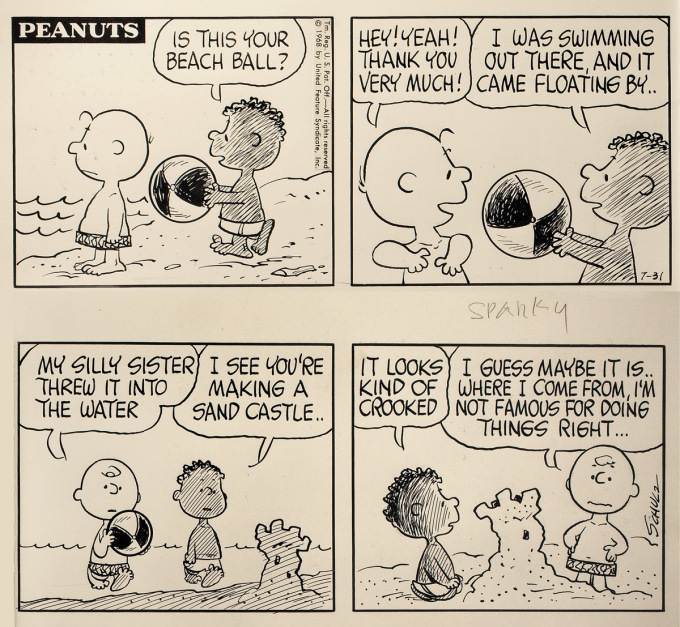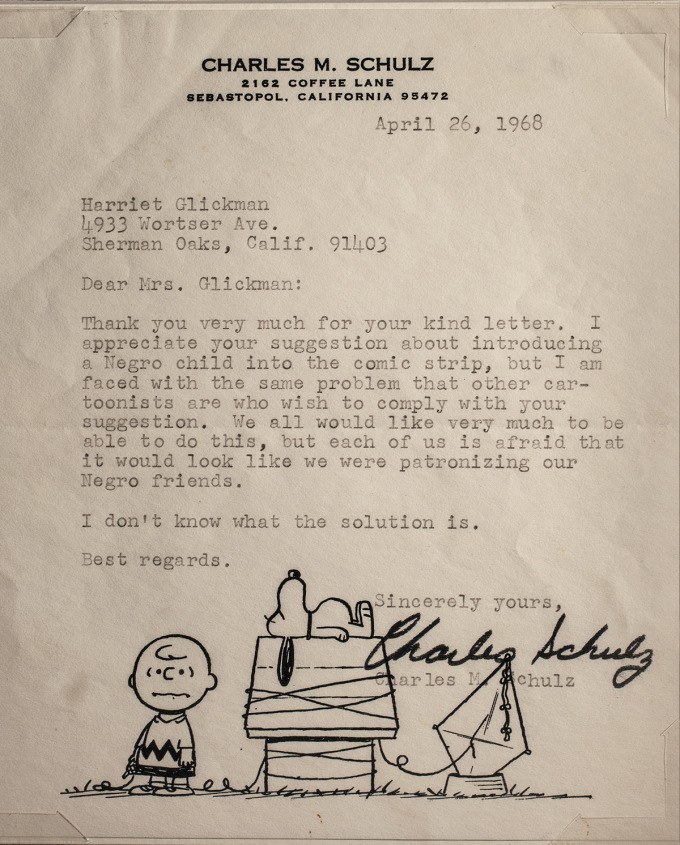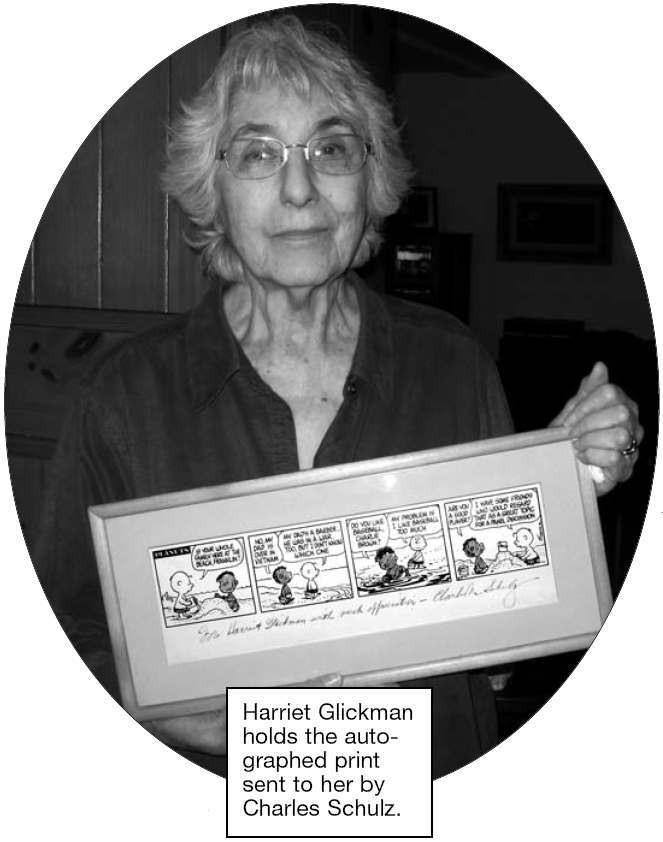People I like can be divided into two groups: a) those who enjoy and get Charles M. Schulz’s wonderful Peanuts comic strip; b) those fools who don’t. All of human life is in the artist and writer’s 17,897 comic strips.
In 1968 Schulz noticed the Civil Rights movement, the assassination of Martin Luther King Jr., and read a letter from Los Angeles schoolteacher Harriet Glickman. She had a question for Schulz: would he include a black child in the Peanuts gang?
Mrs. Glickman wrote:
Dear Mr. Schulz,
Since the death of Martin Luther King, I’ve been asking myself what I can do to help change those conditions in our society which led to the assassination and which contribute to the vast sea of misunderstanding, fear, hate and violence.
As a suburban housewife; the mother of three children and a deeply concerned and active citizen, I am well aware of the very long and tortuous road ahead. I believe that it will be another generation before the kind of open friendship, trust and mobility will be an accepted part of our lives.
In thinking over the areas of the mass media which are of tremendous importance in shaping the unconscious attitudes of our kids, I felt that something could be done through our comic strips, and even in that violent jungle of horrors known as Children’s Television.
You need no reassurances from me that Peanuts is one of the most adored, well-read and quoted parts of our literate society. In our family, teen-age Kathy has posters and sweat shirts … pencil holders and autograph books. Paul, who’s ten and our Charlie Brown Little Leaguer … has memorized every paper back book … has stationery, calendars, wall hangings and a Snoopy pillow. Three and a half year old Simon has his own Snoopy which lives, loves, eats, paints, digs, bathes and sleeps with him. My husband and I keep pertinent Peanuts cartoons on desks and bulletin boards as guards against pomposity. You see … we are a totally Peanuts-oriented family.
It occurred to me today that the introduction of Negro children into the group of Schulz characters could happen with a minimum of impact. The gentleness of the kids … even Lucy, is a perfect setting. The baseball games, kite-flying … yea, even the Psychiatric Service cum Lemonade Stand would accommodate the idea smoothly.
Sitting alone in California suburbia makes it all seem so easy and logical. I’m sure one doesn’t make radical changes in so important an institution without a lot of shock waves from syndicates, clients, etc. You have, however, a stature and reputation which can withstand a great deal.
Lastly; should you consider this suggestion, I hope that the result will be more than one black child… Let them be as adorable as the others … but please … allow them a Lucy!
Sincerely,
Harriet Glickman
Schulz replied, expressing a fear that the sudden appearance of a black child would make him seem clumsy and patronising.
Mrs. Glickman responded:
Dear Mr. Schulz,
I appreciate your taking the time to answer my letter about Negro children in Peanuts.
You present an interesting dilemma. I would like your permission to use your letter to show some Negro friends. Their responses as parents may prove useful to you in your thinking on this subject.
Sincerely,
Harriet Glickman
True to her word, Mrs Glickman showed the letter to others. Kenneth C. Kelly, one of Mrs. Glickman’s ‘Negro friends’, saw the missive and wrote to the artist:
Dear Mr. Schulz:
With regards to your correspondence with Mrs. Glickman on the subject of including Negro kids in the fabric of Peanuts, I’d like to express an opinion as a Negro father of two young boys. You mention a fear of being patronizing. Though I doubt that any Negro would view your efforts that way, I’d like to suggest that an accusation of being patronizing would be a small price to pay for the positive results that would accrue!
We have a situation in America in which racial enmity is constantly portrayed. The inclusion of a Negro supernumerary in some of the group scenes in Peanuts would do two important things. Firstly, it would ease my problem of having my kids seeing themselves pictured in the overall American scene. Secondly, it would suggest racial amity in a casual day-to-day sense.
I deliberately suggest a supernumerary role for a Negro character. The inclusion of a Negro in your occasional group scenes would quietly and unobtrusively set the stage for a principal character at a later date, should the basis for such a principal develop.
We have too long used Negro supernumeraries in such unhappy situations as a movie prison scene, while excluding Negro supernumeraries in quiet and normal scenes of people just living, loving, worrying, entering a hotel, the lobby of an office building, a downtown New York City street scene. There are insidious negative effects in these practices of the movie industry, TV industry, magazine publishing, and syndicated cartoons.
Sincerely,
KCK
Schulz sent Mrs. Glickman a personal note:
Franklin was in the gang.
But would his publishers go for it? Would the readers?
In the 1980s, Schulz recalled the fight to feature Franklin:
“There was one strip where Charlie Brown and Franklin had been playing on the beach, and Franklin said, ‘Well, it’s been nice being with you, come on over to my house some time. [My editors] didn’t like that. Another editor protested once when Franklin was sitting in the same row of school desks with Peppermint Patty, and said, ‘We have enough trouble here in the South without you showing the kids together in school.’ But I never paid any attention to those things, and I remember telling [United Features president] Larry [Rutman] at the time about Franklin—he wanted me to change it, and we talked about it for a long while on the phone, and I finally sighed and said, ‘Well, Larry, let’s put it this way: Either you print it just the way I draw it or I quit. How’s that?’ So that’s the way that ended….
“People say, ‘Don’t you ever deal in social issues?’ ‘Well, don’t you read the strip?’ If you read the strip every day, you’ll see that I deal with more social issues in one month than some of these deal [with] in a whole year. But you have to be a little more sensitive to it.”
Would you like to support Flashbak?
Please consider making a donation to our site. We don't want to rely on ads to bring you the best of visual culture. You can also support us by signing up to our Mailing List. And you can also follow us on Facebook, Instagram and Twitter. For great art and culture delivered to your door, visit our shop.













